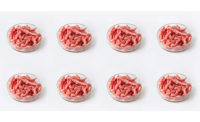From USDA-FSIS annual reports
In recent years, there has been increasing interest in using theE. coliO157:H7 results as an indicator of industry trends or as a measure of program performance. For this reason, the standard table (Table 1) that the U.S. Department of Agriculture’s Food Safety and Inspection Service (USDA-FSIS) has used since 1994 has been revised to illustrate two categories of samples that are collected at both Federal establishments and at retail stores. The revised table uses the following definitions for categories of samples:
Verification Sample from a Federal Plant: Samples that are scheduled each month by randomly selecting establishments from the current population of all raw ground beef producers.
Routine Sample from a Retail Store: Samples that are collected by program investigators in the course of making a routine visit to a retail store.
Follow-Up Sample: Samples that are scheduled in response to a positive finding from an initial HACCP verification sample or a routine retail sample. Sample collection may or may not be the same as the location where the initial positive sample was collected. Follow-up samples include both sampling to verify corrective action and sampling to help identify the source of the contamination.
FSIS views results from the “Verification” samples from Federal establishments as the best indicator of the overall trend of the presence ofE. coliO157:H7 in raw ground beef. For this reason the Agency uses the percentage of positives in these samples as one of its key performance measures. Figure 1 shows the graph of this performance measure on an annual basis from 2000 through 2007.
When the Agency posted the results from 2006, it was noted that the results for the last quarter of 2006 represented the first time a three-month quarter result had been above 0.20 percent since April-June of 2004. Because FSIS had the performance measure aimed at keeping the percentage of ground beef positives below 0.20 percent, the Agency was concerned about the result showing 0.21 percent even though it seemed consistent with other recent quarter patterns and the overall results for 2006 were the same as for 2005. At the time FSIS indicated the Agency would closely monitor the 2007 results to assess whether there is any evidence of an increasing trend. Because the performance measure was clearly exceeded during 2007, FSIS initiated several actions that are summarized atwww.fsis.usda.gov/News_&_Events/NR_102307_01_att/index.asp.
Using sample results and other data sources, FSIS continues to evaluate itsE. coliO157:H7 policy and testing programs. In 2007, FSIS began routine testing of beef trimmings and other raw ground beef components. In January 2008, FSIS implemented a targeted sampling program that incorporates production volume and history of sample results. The agency also implemented a change in the laboratory method that is expected to increase the Agency’s ability to detectE. coliO157:H7 at very low levels. The effect of these January 2008 changes will be further discussed when the 2008 results are posted.
For the full FSIS report on the Web, visit http://www.fsis.usda.gov/science/Ground_Beef_E.Coli_Testing_Results/index.asp.
Get our new eMagazine delivered to your inbox every month.
Stay in the know with The National Provisioner's comprehensive coverage of the meat and poultry processing industry.
SUBSCRIBE TODAY!Copyright ©2024. All Rights Reserved BNP Media.
Design, CMS, Hosting & Web Development :: ePublishing

Report Abusive Comment